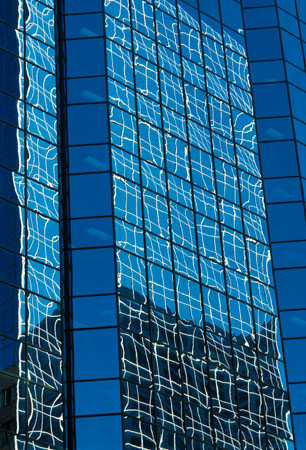
Skyscrapers dominate the skylines of modern cities, particularly in their business districts. These modern buildings often have interesting shapes and unusual features as architects strive to achieve unique designs, and seem to rise ever higher abobe the ground. Located in congested areas, and surrounded by other large structures, skyscrapers can be very difficult to photograph. It is often impossible to get a clear view of the whole structure, and when seen from a distance they may look less impressive.
 Looking up at a high building from street level and using a wide-angle lens produces significant linear distortion. If this is the only approach available, use the effect to advantage, perhaps emphasizing the extreme height of the structure by showing it taper in to the distance. The camera can even be rotated slightly so that the tower angles across the image to give a more dynamic composition.
Looking up at a high building from street level and using a wide-angle lens produces significant linear distortion. If this is the only approach available, use the effect to advantage, perhaps emphasizing the extreme height of the structure by showing it taper in to the distance. The camera can even be rotated slightly so that the tower angles across the image to give a more dynamic composition.
Looking upward in this way poses a number of problems regarding exposure. The top of the building is seen against a bright sky and the base may be in shadow. The contrast may be extreme. Expose for the mid-range areas and expect the top of the building to be over exposed and the base to be somewhat under exposed. Some correction can be done in Photoshop at a later stage. An alternative approach is to create a high-dynamic-range (HDR) image by exposing a series of identical shots at a range of exposures and then using image-processing software to combine the properly exposed ares of each.
Never overlook the opportunities provided by reflections in glass-covered skyscrapers. These are often interesting subjects in their own right. The glass panels are always misaligned to a certain extent, so the overall reflection is attractively distorted. Reflections can also be incorporated into a wider image incorporating much of the building. They add colour and interest to otherwise uniform surfaces.






